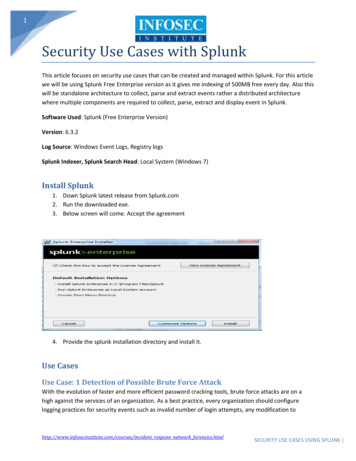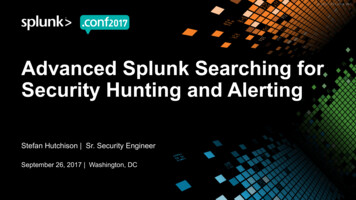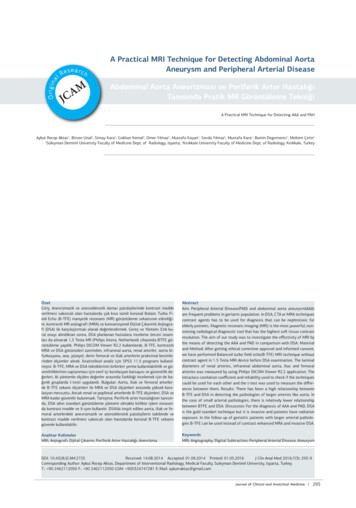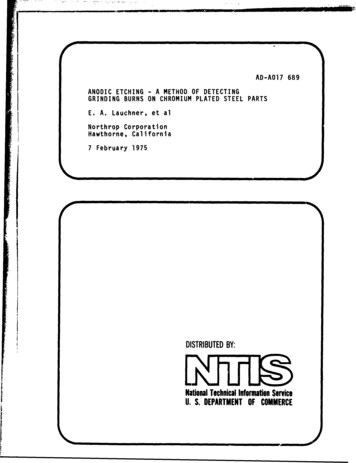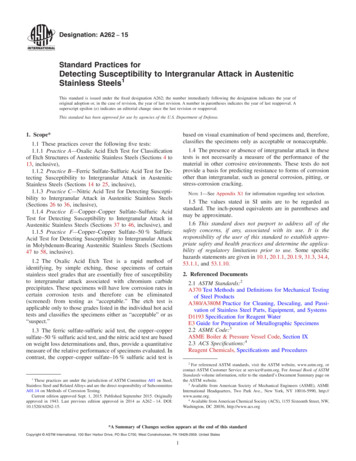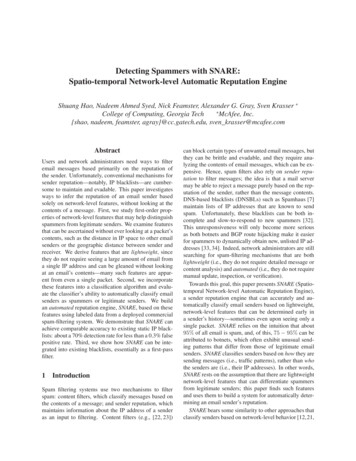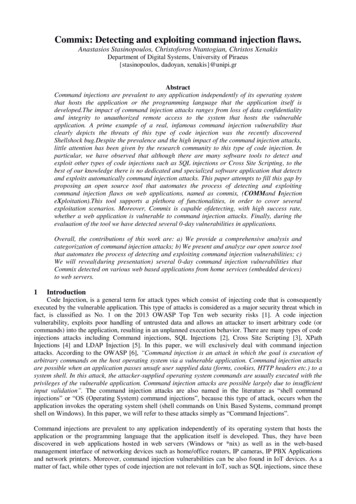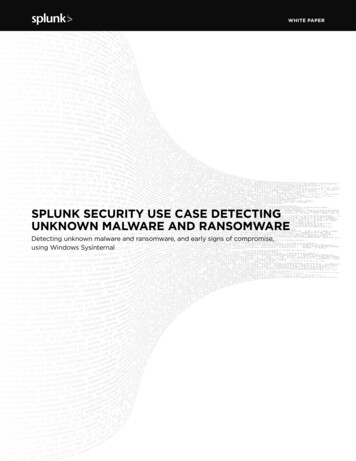
Transcription
WHITE PAPERSPLUNK SECURITY USE CASE DETECTINGUNKNOWN MALWARE AND RANSOMWAREDetecting unknown malware and ransomware, and early signs of compromise,using Windows Sysinternal
WHITE PAPERRansomware is a specific type of malware that holdsThe challenges with collecting sysinternal data fromdata “hostage,” and is especially disruptive to businessall endpoint is that it requires coordinating effortsdue to its data-destructive nature. The ransomwareand proper outside technology that installs a lightthreat doesn’t need to keep security practitioners upagent at Windows Endpoint that could collectat night. Detection of ransomware is key to removinggranular sysinternal events in real time from manycompromised devices from an infected networkWindows systems. Once the details of the Windowsbut a holistic approach to security, centered aroundactivity, in event log format from the endpoint isprevention, is necessary to keep organizations fromcollected, it needs to be stored in a data platformfalling victim to malware attacks.that could handle the volume of messages andThis paper will take users on a step-by-step journeyon how to detect unknown malware activity and earlybe able to search and analyze system activitieseffectively to find anomalies.signs of compromise in a Windows environment.SolutionThese techniques can be applied to detect malwareSplunk forwarders enable users to collect theand ransomware using Windows Systinternal events.Windows infrastructure’s Sysmon data from theThe Challenge to Detecting MalwareThe traditional way of detecting an advancedmalware or threat compromise in a Windowsendpoint in real time. Splunk software automaticallytransports the events that are relevant for analyzinganomalies to the endpoint.environment relies on using a signature based anti-The Splunk platform provides two key functionsvirus or malware product. But this approach can beto solve the challenges of making the best use ofdifficult for many. Most anti-malware solutions thatsysinternal events for detecting early signs of knownare signature based rely on a known list of signatures.advanced malware infections:And this comes with challenges because signaturebased detection will not catch everything because: Endpoint protection products don’t have a perfectlist of threats to detect all signatures that exist They don’t apply to new types of threats that areexecuted as new executables at the endpoints becausethere is no known signature to compare againstThis traditional approach is forcing organizationsto deal with security breaches ranging from dataexfiltration, service interruptions and ransomwarethat all center with the inability to protect and detectthe activities on endpoints.Fundamentally the problems lie with organizationsbeing unable to utilize the Windows system activitiesevents that could be collected from Windowsinfrastructure. As well as applying analytics to thatdata, to determine what is normal versus what isabnormal, by reviewing all the processes and sessionscreated at Windows Endpoint.1. Collections of Windows activities: The SplunkWindows OS-based forwarder to easily collects allsysinternal data through event logs Provides a simple agent for collecting all Windowsdata (event log, sysinternal, perf mon, files) Allows secure and highly confident transportmeans for centralizing data in an analyticsplatform Sysmon specific formatting and process abilityto immediately apply analysis2. Analytics base for searching and analyzinganomalies: Using simple search, statisticalsummation and calculation to highlight rare valuesin process creation details. Pivots into different endpoint criteria todynamically derive results Applies machine learningBy applying an analytical approach to the data, theSplunk platform allows users to identify abnormalitiesin the activity endpoints by eliminating a normalpattern in statistical calculation. The use of thisSplunk Security Use Case – Detecting Unknown Malware2
WHITE PAPERtechnique can be widely used with 1) any Windowsbased server infrastructure 2) or by collectingsysinternals from all Windows clients. This use casecan be applied to the majority of security operations.Regardless of whether the organization already hasan endpoint security solution or not, the wealth ofinformation provide significant value to assess thesecurity of an endpoint. There also could be otheruses of the sysinternal where it will add more contextto either IT operations and service analysis.Data SourcesData sources that are required to detect the potentialactivities of malware on Windows Endpoint issysinternal collected through Windows event logusing Sysmon. An organization can gain detailedinformation by installing Sysmon provided byMicrosoft, then installing Splunk forwarder todefine what needs to be collected and filtered. Thissysinternal data is where finding the indications ofodd activities would begin, but additional correlationto trace the how and what got infected; furtheringesting proxy, IDS/IPS, DNS/stream data isrecommended to root case the route of a potentialinfection and determine the scope and mitigate theincident. Analyzing the sysinternals through Splunksoftware would provide definitive indications ofcompromise in detecting potential of any malware,Example of Windows event log through sysmon File creation time changes Boot process events that may include kernel-modemalwareCollection of Windows Activities EventsCollecting various pieces of information from theWindows infrastructure is easy with the Splunkforwarder.whether it’s known or unknown.Here are a few simple steps to collect and integrate Windows Sysinternals using Sysmon through eventSysmon data into the Splunk platform:log (required) Proxy, IDS/IPS, DNS, stream (recommended forfurther investigation beyond detection)Event log with Sysmon installed provides thefollowing details to be collected in Splunk software: Process creation including full command line withpaths for both current and parent processes Hash of the process image using either MD5, SHA1or SHA256 Process GUID that provides static IDs for better1. Install Sysmon on your Windows-based endpoint,which can be downloaded from the following ls/dn7983482. Install Splunk forwarder on the endpoint and itwill forward sysinternal messages in real time to aSplunk instance3. Install Splunk Add-ons for Microsoft Sysmon andeasily configure Splunk to extract and map to CIM.Download it ations as opposed to PIDs that are reusedby OS Network connection records from the host toanother includes source process, IP address, portnumber, hostnames and port names for TCP/UDPSplunk Security Use Case – Detecting Unknown Malware3
WHITE PAPERData collected in XML format with sysinternal eventsare all parsed into fields in the Splunk platform withthe help of the Splunk Add-on for Sysmon. Browsingthrough complex sysinternal events is now easy, justpoint and click on parsed fields.Once Sysmon is installed, you can use Splunk’s “datainputs” to decide what you want, just select the typeSearching for Process Creation Anomaliesof event logs to transport to the Splunk Indexer.The challenge is, how do we protect against theNow that you have events in the Splunk platformthere is a wealth of information available to you.The basic search to call the sysinternal events fromSplunk index is:unknown? Unknown here means that there is no listto verify against things that are not just defined eitherright or wrong, but what’s right or wrong derivesfrom the data itself. It is based on calculated resultswith the understanding of what is the majority versussourcetype ”XmlWinEventLog:Microsoft-the minority and associates other analytical detailsWindows-Sysmon/Operational”related with them.The following is an example of data collected inObjective of the Analytics ApproachSplunk software. Windows event log format isDetecting changes of activities entails findingconverted into XML combining all different fields intoanomalies by comparing what happened in the pasta single line event.to what is happening now. Event xmlns ’http://schemas.The elements to validate different aspects ofmicrosoft.com/win/2004/08/events/determining anomalies are:event’ System Provider Name ’MicrosoftWindows-Sysmon’ Guid ’{5770385F-C22A43E0-BF4C-06F5698FFBD9}’/ EventID 1 /EventID Version 5 /Version Level 4 /Level Task 1 /Task Opcode 0 /Opcode Keywords 0x8000000000000000 /Keywords TimeCreated SystemTime ’201602-04T01:58:00.125000000Z’/ EventReco What is pre-existing and new? What are the statistics on pre-existed versus newto validate which is old (being normal) and new (assomething that needs to be validated)? What are the time relations of existed and newentities? The association between an existing entity andrdID 73675 /EventRecordID Correlation/other entities, such as the number of assets Execution ProcessID ’1664’ ThreadID ’185associated with it.6’/ Channel Microsoft-Windows-Sysmon/Operational /Channel Computer FSAMUELS /Computer Security UserID ’S-1-5-18’/ /System EventData DataSplunk Security Use Case – Detecting Unknown Malware4
WHITE PAPERnow we can eliminate the normal to filter out theMalware Process Hiding as Existing OS orApplication Processanomalies that are most likely to be evaluated andMost PC users have experience looking at Windowsanalyzed.process monitor, finding no particular problems whereUtilizing insights related to validating anomalies,These kinds of distinctions are possible when thestatistics of different entities are compared to eachother.the OS seems to be running all the normal processes.Regardless of who may appear to be the user, weknow that the PC is infected with all kinds of malware.An example of a “black sheep” malware disguisingWindows Sysinternal provides extensive detail intoitself as a normal OS process is when malwareunderstanding the status of endpoints in termsprocesses run as if they are normal processes. Howof endpoint security and vulnerability. One of thecould this kind of “black sheep” be detected?notable powers of analyzing sysinternals is theability to gain visibility into what processes and filesare installed and executed. There are events relatedto the execution of processes, indicating activitieson the system which provides critical sources ofinformation to help security analysts understand: What processes have been executedWhat about in the case of advanced malware, forexample, a type malware that has never been knownor detected by an anti-malware software product?This type of malware would be executed on anendpoint limiting the ability of most anti-malwaredetection software to raise a red-flag because thesignature of the new executable is not known. Could What is the directory origin of the executablethis kind of problem be tackled using analytics? What is the parent process that executed theAnalytics that compare a set of criteria from differentexecutable What is the fingerprint of the executed processAll of these insights gained from the sysinternals are acritical part of collected system activity information inapplying analytics to find anomalies of processes andaction executed in an endpoint. This is an easy taskwith the data collected from the different Sysmonsources. Using Sysmon’s hash information attached toeach process creates events as MD5, SHA1 or SHA256,and an analyst can identify different versions of acertain system executable.For example, why do we care about the full path ofa process “cmd.exe?” Even though the “cmd.exe” isa legitimate looking executable on Windows, we cansee the odd path of the binaries, potentially linking itto a “black sheep.” How about the MD5 hash of thebinary “cmd.exe” that is different from all the other“cmd.exe” in the network? This is a clear indication ofexecutable fingerprints.In order to find this, hashes on the Sysmon eventplay a key role. The hash information that getsattached to the Sysmon process creation eventrepresents a unique fingerprint of an executable. Ifwe were to find out what those existing fingerprintsof trusted executables were versus comparing thenew fingerprint for a similar executable that startedrecently, we can find the processes that are anomalies.This detailed Sysmon event about created processesand their associated hash can be analyzed with simpleSplunk SPL summation by executable name.This lists unique counts of executables regardless ofhow the executables are disguising themselves. Afingerprint of a hash means a non-arguable unique fileor executable executed. On top of that sum the countof those unique hashes indicates what needs to belooked at more closely.file manipulation, potentially malicious code hiding asa legitimate executable.Splunk Security Use Case – Detecting Unknown Malware5
WHITE PAPERSearch Syntax Below:sourcetype onal” Image *svchost.exe dedup Computer eval TIME strftime( time,”%Y-%m-%d %H:%M”) stats first(TIME) count by Image, HashesThe search to find all the same executable names with different hashes.Based on the result of the search, the same executables svchost.exe with the exact same paths were found, butnotice the hashes are different. This means that there are two variants of Windows OS, because this infrastructureis running a good balance of hosts that are Windows 7 and Windows 8. This seems normal because given the sizeof the network with more than 200 hosts, the distribution of hashes for a critical system process “svchosts.exe”is distributed at the quantity of each Windows version. Notice the sum of the instances, knowing the basic factsabout the infrastructure running two versions of OS and seeing a good count of both results, we can concludethat things look normal.In the following example, imagine the same search returns as in the previous example. The result shows a similarnumber of distributions for the first two majority hash executables, but it shows the third one with fewer hostswith a new SHA1 hash found. This means that the same executable with a different hash and a significantlylower number of process creations means this is a new executable executed with the same name as a systembinary. The sum of counts of “1” indicates it’s a rare frequency, not likely to be seen as a system executableunless we have another new version of OS with different system executables running on the network. If this isnot the case, then this is a suspicious hash that needs to be referenced against a Google search.Additionally, the “first(TIME)” function indicates the first time the anomalous executable was created andindicates that it is definitely a new process compared to the normal svchost.exe executables created before.The first time function provides insight into what existed versus what is new and correlating the sum ofcounts determines what is abnormal. The third hash and newer timestamp executable with a minor number ofoccurrences is most likely malware that potentially an anti-virus program didn’t detect.Splunk Security Use Case – Detecting Unknown Malware6
WHITE PAPERMake sure to verify what hosts are associated withUnderstanding the nature of the manipulation tactics,the hashes for two different normal svchost.exe, aswe can define a query that filters automaticallywell as which hosts are involved in potential malwareby applying calculated steps that consider theactivities. This can be accomplished by listing uniquequantitative contrast of process creation count withvalues in the “computer” field from Sysmon data,existing and newly executable hashes. You can useusing the values (Computer) function.“eventstats” to calculate the sum of all occurrencessourcetype nal” Image *svchost.exe dedup Computer eval TIME strftime( time,”%Y-%m-%d %H:%M”) stats first(TIME), count, values(Computer) byImage, HashesAfter analyzing a process with new hashes, we canconclude a couple of conditions to define a potentialand apply this to calculate the percentage ofoccurrences of each individual executable to make iteasy to define a relative threshold that would pick outthe “odd executables,” even those that are maskingthemselves as sheep.Search Syntax Below:sourcetype nal” Image *svchost.exemalware sneaking in as a system process: dedup Computer The process may look normal from the path and stats first(TIME) count by Image, Hashes eval TIME strftime( time,”%Y-%m-%d %H:%M”)name of the executable, but the hash of the new eventstats sum(count) as total hostexecutable in comparison with existing historical eval majority percent round((count/totalhashes are different.host)*100,2) The frequency of process creation in contrast withan existing executable hash is significantly different.Splunk Security Use Case – Detecting Unknown Malware7
WHITE PAPERNow, how do we define a search (rule) to have Splunkus and automatically send the analyst alerts on thesoftware look for these kinds of odd executables?anomalous processes that could start up in any one ofExpanding upon the previous relative quantitythe Windows workstations running on the network.calculation and applying the “majority percent 5” willSummaryeliminate the normal groups and expose the anomalousBy using Splunk Enterprise and Microsoft Sysmon,executable group based on relative threshold.security analysts can gain a significant understandingsourcetype nal” Image *svchost.exe dedup Computer eval TIME strftime( time,”%Y-%m-%d %H:%M”) stats first(TIME) count by Image, Hashes eventstats sum(count) as total host eval majority percent round((count/totalhost)*100,2) where majority percent 5This kind of recipe can be applied to SplunkEnterprise’s saved search or Enterprise Security’scorrelations search feature to do the analysis forof detailed activities on endpoint, as well as theability to detect advanced and unknown malwareactivities. Statistical analysis of detailed endpointdata risk in quantitative values for analysts to easilyprofile behavior of compromised hosts by adversariesand further define rules based on those valuesas threshold. This empowers security analysts toapply similar techniques to solve problems and usecases that could be addressed by only an analyticalapproach. Analytical approaches that contextuallydistinguish the differences and anomalies provide thesecurity operations to detect advanced threats fasterin order to ultimately minimize business impact.Learn more about combating malware and ransomware by exploring security investigation use cases in Splunk’s free,online demo environment.Learn more: www.splunk.com/asksales 2017 Splunk Inc. All rights reserved. Splunk, Splunk , Listen to Your Data, The Engine for Machine Data, Splunk Cloud, Splunk Lightand SPL are trademarks and registered trademarks of Splunk Inc. in the United States and other countries. All other brand names,product names, or trademarks belong to their respective Unknown-Malware-104
activity, in event log format from the endpoint is collected, it needs to be stored in a data platform that could handle the volume of messages and be able to search and analyze system activities effectively to find anomalies. Solution Splunk forwarders enable users to collect the Windows i
